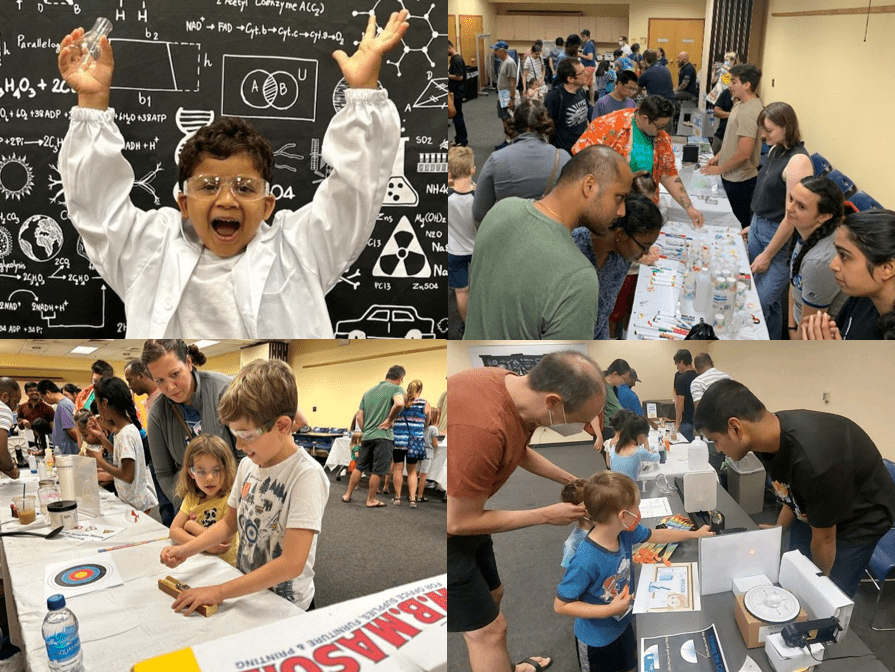Lending Library for STEM Teachers
Brought to you by the UD College of Engineering

COE’s STEM Lending Library is a resource for local K-12 educators to bolster STEM education in their classrooms via hands-on instructional materials. These easy-to-use kits provide materials and instructions on a variety of STEM topics related to Next Generation Science Standards and are available to borrow for FREE.
Please request kits no less than 3 weeks in advance of requested borrowing date. You will receive a confirmation email once your request has been received with confirmation and additional details.
Target Grade Level
Ⓔ Elementary Level ⬩ Ⓜ Middle School Level ⬩ Ⓗ High School Level
STEM-Related Subject
🧪 Chemistry ⬩ 🧬 Biology ⬩ ⚛️ Materials Science ⬩ 💡 Physics ⬩ 📐 Math
Kits listed below are “active” and available to request to borrow.
DIY Boba Balls ⬩ ⚛️ 🧪 Ⓜ Ⓗ
Audience: Grades 6 – 12
Subject/topics covered: materials science, chemistry, polymers
NGSS standard(s): MS-PS1-1, MS-PS1-2, MS-PS1-6, HS-PS2-6
Boba is a flavor-filled, edible sphere that contains a juice liquid inside of a soft, clear shell. Discover how chemical reactions can change the shape of ingredients and just how boba shops can get liquid inside of edible beads! For safety, we encourage students to not eat their resulting boba balls from this activity.
-
- PDF handout
Diaper Dissection ⬩ ⚛️ Ⓔ Ⓜ
Audience: Grades 3 – 8
Subject/topics covered: materials science, chemical engineering
NGSS standard(s): 5-PS1-3, MS-PS1-1
How do diapers hold so much liquid? Discover the materials that goes into the making of diapers in this activity and why different materials have different abilities to soak up and store liquids.
-
- Editable Word document handout
- PDF concepts handout
Elephant Toothpaste ⬩ 🧪 Ⓔ Ⓜ Ⓗ
Audience: Grades 4 – 10
Subject/topics covered: chemistry, catalysts, heat
NGSS standard(s): 5-PS1-4, MS-PS1-2
In this activity, students will focus on a specific chemical reaction between hydrogen peroxide and a catalyst. This flashy reaction is perfect to use in order to discuss exothermic reactions, decomposition reactions, and reactions requiring catalysts.
-
- PDF instructions and background
Ohm's Law ⬩ 💡 Ⓗ
Audience: Grades 9 – 12
Subject/topics covered: physics, energy, ohm’s law
NGSS standard(s): HS-PS3-1, HS-PS3-3
How does changing the angle of a solar panel affect the energy it absorbs? This unit teaches students about the basics of solar panels, testing different sources of lights, and analyzing the relationship between voltage and current.
-
- Full PDF of teacher and student documents
- PDF of student handout
Converting Light to Energy ⬩ 🧬🧪💡 Ⓗ
Audience: Grades 9 – 12
Subject/topics covered: biology, chemistry, physics, energy, photovoltaic devices, photosynthesis, pigments & dyes
NGSS standard(s): HS-LS1-5, HS-PS3-3
Can spinach and blackberries power a solar cell? This unit helps students continue to understand the properties of light, identify the role of chlorophyll in photosynthesis, and better understand the relationship between photons and electrons.
-
- Full PDF of teacher and student documents
Stinky Bat Balloons ⬩ ⚛️ Ⓔ
Audience: Grades K-3
Subject/topics covered: materials science
NGSS standard(s): 2-PS1-1, 5-PS1-3
Polymers are materials that are widely used across all areas of life. They even make up our birthday balloons and protective rubber gloves! In this activity, students discover the versitile nature of polymers and why we’re able to smell liquids in balloons without any leaks.
-
- PDF handout
Location: Basement Shelf 3
Chocolate Composites ⬩ ⚛️ Ⓔ Ⓜ
Audience: Grades 2 – 8
Subject/topics covered: materials science
NGSS standard(s): 2-PS1-1 & 2, 2-PS1-4, K-2-ETS1-1 to 3, 5-PS1-1 to 3, 3-4-ETS1-1 to 3, MS-PS1-1 to 4, MS-ETS1-1 to 4
Learn about how differently structured materials break apart in this deliciously educational experiment. Eat your way through a lesson about brittle and ductile fractures, designed by UD K-12 Engineering and Composite Materials students.
-
- Master PDF with content and handouts
Friction, Fluids, & Flow ⬩ ⚛️ 💡 Ⓜ Ⓗ
Audience: Grades 7 – 10
Subject/topics covered: materials science, physics, chemistry
NGSS standard(s): MS-PS1-2, MS-PS3-1
Water, honey, and toothpaste are all liquids/fluids, however, they all move and behave differently. In this activity, students will discuss the ideas of viscosity, friction, and fluid behavior.
-
- Friction, Fluids, Flow handout
- Viscosity lesson plan
- Viscosity worksheet
- Understanding Viscosity slide deck
Solar Panels & Photons ⬩ 💡 Ⓗ
Audience: Grades 9 – 12
Subject/topics covered: physics, energy, solar energy
NGSS standard(s): HS-PS4-1, HS-PS3-1, HS-PS3-3
How do chemical and nuclear reactions produce light? And how can this information be applied to solar panels? This unit teaches students about light spectra, how electrons and photons behave, and how solar cells convert solar energy into electricity. In the lab, students will use solar cells, multimeters, and different light sources to gather their own data for analysis.
-
- Full PDF of teacher and student documents
- PDF of student handouts
Keep coming back and keep an eye out as our library grows!
Coming Soon:
Cleaning Up Oil Spills
Electromagnets
Fairytale Energy Conservation
Filter Feeding Sponges
Punkin Chunkin
Super Slime Engineering
Strawberry DNA Hydrogels
Collision Events
…and more!
